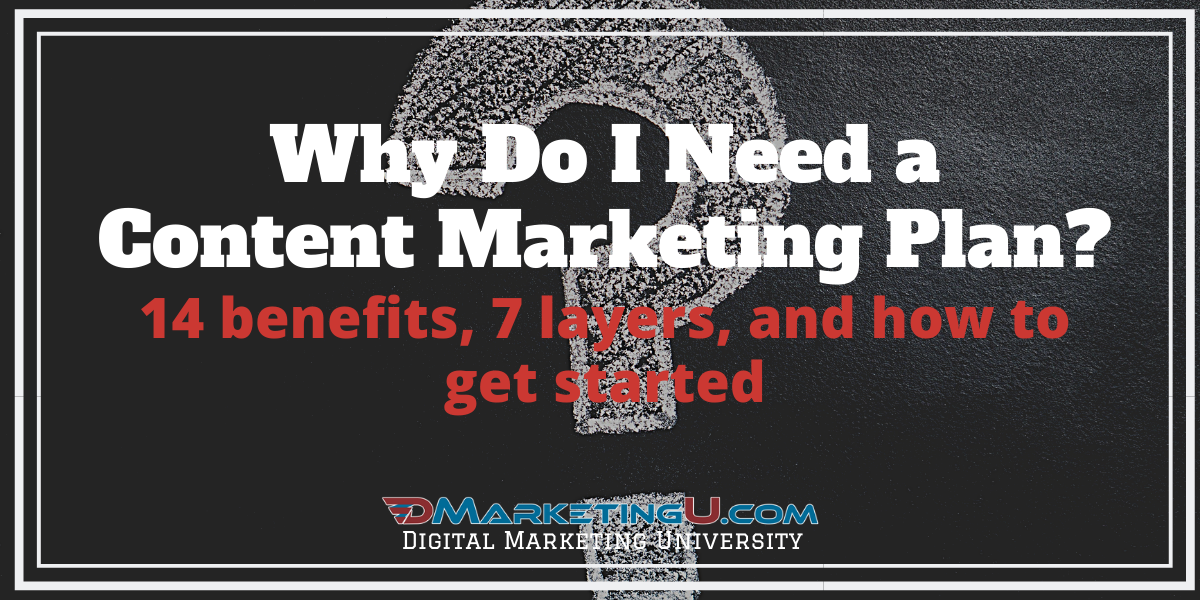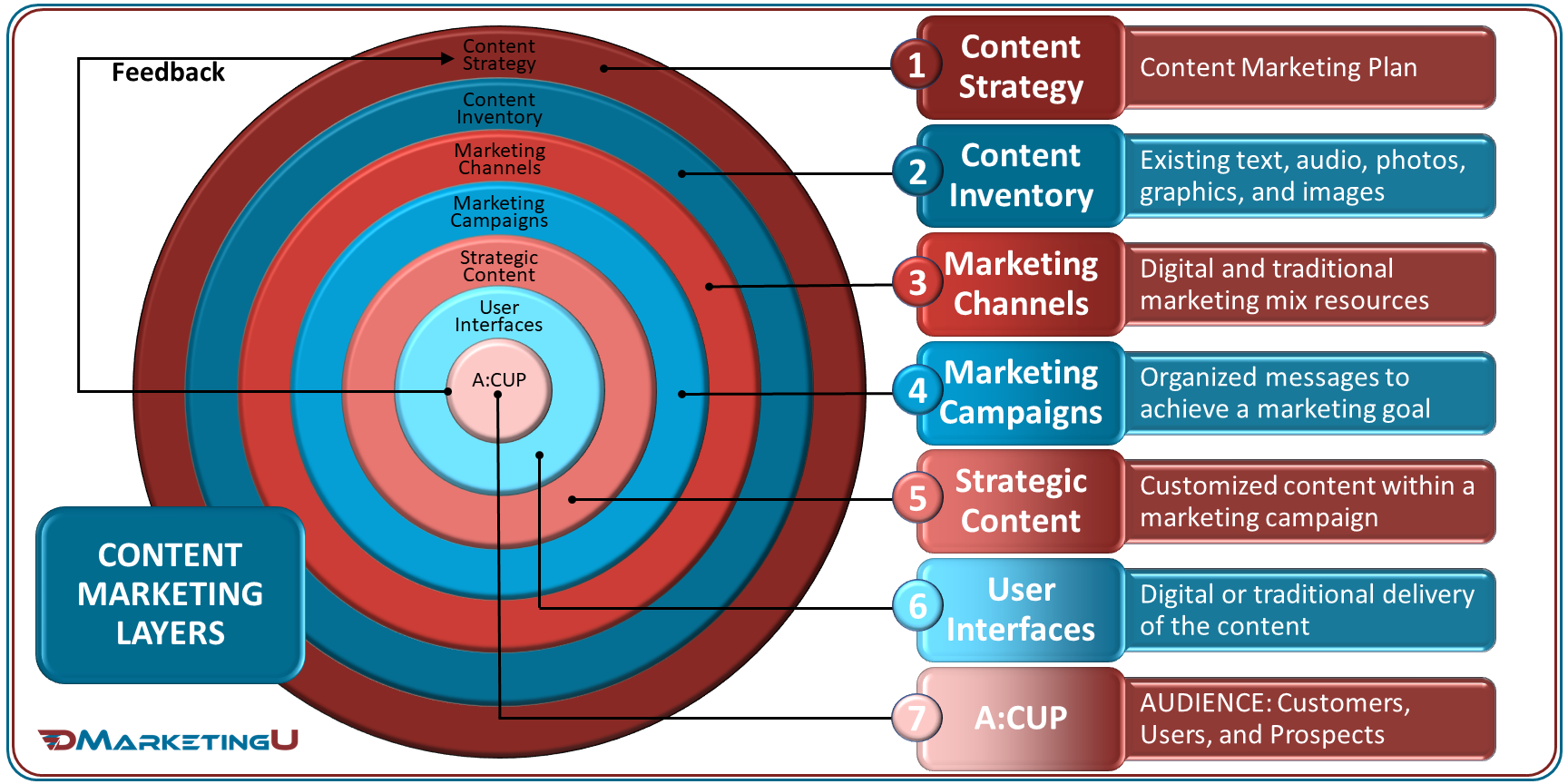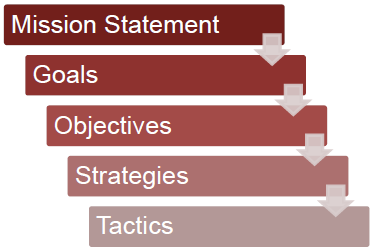
Why Do I Need a Content Marketing Plan? [14 benefits, 7 layers, and how to get started]
Content Marketing is a field that is dynamic and challenging… the rules and algorithms are always changing, technology is rapidly advancing, plus the needs of your prospects and customers are regularly fluctuating. These shifting factors mean that you’re probably struggling in at least one of the following Content Marketing areas:
- Attracting website or social media post traffic when organic methods underperform.
- Building loyalty with your customers.
- Consistently creating high-quality content.
- Creating awareness of your brand, products, and services.
- Generating more qualified leads and sales.
- Growing your email list.
- Posting content that generates high engagement and starts discussions.
- Reaching a targeted audience.
- Reducing the time and cost to create content and promote it.
To succeed in Content Marketing and overcome the obstacles, you must create a strategic Content Marketing Plan—a professional, comprehensive document that guides the planning, creation, publishing, reporting, and optimization of your future content.
Unfortunately, a recent survey from the Content Marketing Institute showed that 63% of marketers don’t have a documented strategy (graphic below), so they’re missing the opportunity to truly benefit from Content Marketing.

14 BENEFITS OF A CONTENT MARKETING PLAN
Content Marketing is an investment strategy where your goal is to achieve a high ROI (return on investment) from the content that you create and publish. Just as a financial planner will say that you need an investment strategy for your financial portfolio, you also need an investment strategy for your content portfolio. Here are 14 benefits that you can achieve by investing time to create a Content Marketing Plan:
- ACCOUNTABILITY – Management and team members become accountable for the plan’s goals and its actionable tactics.
- AUDIENCE – Acquire an in-depth understanding of your prospects, buyers, and users that will make you better at targeting ads, customizing campaigns, and personalizing content.
- GOALS – Your goals, objectives, strategies, and tactics will provide guidance and a sense of purpose for your team.
- LEADS – With a better strategy and customized content at the top of your sales funnel, you’ll attract more qualified leads.
- REACH – Strategically-targeted content will help you reach specific audiences that generic content couldn’t attract.
- RELATIONSHIPS – Improved content will help you build stronger relationships with customers, users, and prospects for long-term loyalty.
- REPUTATION – Enhance your brand reputation as a thought leader from better conversation-starting content.
- RESULTS – Achieve better results from marketing campaigns due to better content, strategic planning, and efficient publishing and promoting of the content.
- ROI – Continuous improvements will be achieved from content optimization techniques and repurposing of content, resulting in higher ROI (return on investment) from your content.
- SALES – Shorten sales cycles by developing content that expedites buyers through their journey to becoming a customer.
- SAVE – Attain cost and time efficiencies when creating content because of standardized project workflows and procedures.
- SEO – Improved SEO (search engine optimization) rankings from higher quality content that matches the needs of your audience.
- SUBSCRIBERS – High-quality content will grow your email list because you’re providing value and building trust.
- TRAFFIC – As a result of higher quality content from your new strategic plan, search crawlers will love your content and drive more organic (free) traffic to your website.
7 CONTENT MARKETING LAYERS
After justifying why you need a Content Marketing Plan, the next step is to figure out where the strategic plan fits compared to other aspects of Content Marketing. The graphic below illustrates the seven “Layers of Content Marketing” for your strategic planning, which includes the core layer plus six supporting layers around it.

As shown in the graphic, your audience—consisting of your customers, users, and prospects—is the core layer (layer #7). The six layers around it help you achieve your marketing goals, provide solutions for your audience, allow you to reach your audience, and create a positive user experience.
To go more in-depth, here are descriptions of each of the seven Content Marketing Layers:
- CONTENT STRATEGY – As the outermost layer, it’s the most important layer besides the core—since your audience and their needs are always the most critically important factor in marketing. This layer is a documented strategy with goals, objectives, strategies, and tactics to help your organization create, publish, monitor, report and optimize content to help you reach your target audiences, fulfill their needs, plus achieve your goals and objectives.
- CONTENT INVENTORY – Think of this layer as your vault of content assets consisting of every piece of text written for a blog or marketing asset, photo taken, graphic designed, audio or video file recorded, and every piece of marketing collateral saved in your arsenal. Simply, it’s all of your existing content.
- MARKETING CHANNELS – Each channel in your marketing mix is included in this layer. Typical digital channels include social networks, websites, mobile apps, blogs, email, and more. More traditional marketing channels include print, radio, TV, direct mail, trade shows, and more. Combined, they are the touchpoints to reach your audience.
- MARKETING CAMPAIGNS – Your marketing campaigns at this layer are the planned messages and strategic content to reach a targeted audience to solve a problem for that audience and achieve a marketing goal.
- STRATEGIC CONTENT – From your content inventory of existing or new content, this layer represents the specific content that you’ve chosen to put into a marketing campaign for the targeted audience.
- USER INTERFACES – This is the last layer to help your audience view your content using strategic methods and designs (or interfaces) that will display your content in each marketing channel. Typical digital interface factors include template layouts, screen size, and device type. Traditional interface factors include paper type and size, volume and tone of audio for radio, text size and image sizes on TV commercials and billboards, and even the size and design of a trade show booth. This layer contains all of the factors that interact with the senses (sight, sound, touch, etc.) of your audience.
- A:CUP – Because I believe in the customer-first mentality, the core layer is your “A:CUP” or Audience of Customers, Users, and Prospects. Since not all buyers are users, and not all users are always buyers, you must always include all three audience types in your strategic planning for Content Marketing.
If you review the “Content Marketing Layers” graphic one more time, you’ll notice on the left side is a Feedback arrow starting at the core (A:CUP) and looping back to the outer layer (Content Strategy). This arrow first represents that these layers are a continuous process since factors are frequently changing in the Content Marketing world. Secondly, the arrow represents that you should always be gathering feedback and analytics data from your audience and using that information to update your strategic plan and optimize your content, goals, processes, and workflows.
Now, let’s put all seven layers together into a real-world scenario:
- When I work with my digital marketing clients on developing a strategic plan, I start with a thorough analysis of the top targeted audiences (the core at layer #7). I analyze and document their problems, desired solutions, habits, attitudes, demographics, beliefs, decision factors, search behaviors, and more.
- Next, I work with the client to document their goals, objectives, strategies, and tactics into a Content Marketing Plan (layer #1).
- Before I can create a marketing campaign (layer #4) to achieve a marketing goal, I must first review the client’s content inventory (layer #2) to determine if we can utilize existing content, if we need to create new content, or design a hybrid of old and new content. If new content is needed, we’d start a content creation project as part of the marketing campaign.
- Once I analyze the content needed and available, I’d exam the best marketing channels (layer #3) that will be effective as touchpoints to reach the targeted audience.
- With the content and channel analysis complete as prerequisites, together we would begin the planning of a marketing campaign (layer #4) for a specific time period and incorporate the strategic content (layer #5) that we’ve chosen from their content inventory.
- Based on the target audience’s preferences, we’d design and use the most effective user interfaces (layer #6) to display the content for the audience.
- Finally, together we’d launch the marketing campaign then implement monitoring and communication systems to gather feedback and analytics data (Feedback loop arrow) so we can have continuous improvements to the Content Marketing Strategy.
GETTING STARTED WITH YOUR CONTENT MARKETING PLAN
With an understanding of the benefits and layers of Content Marketing, you’re ready to get started with creating your own Content Marketing Plan! There are many techniques and templates available, but try this three-phase approach to build a solid foundation for your plan.
Phase 1: Audience Analysis
My recommendation—from experience helping my clients develop their strategic plans—always begins at the same point… Audience Analysis. If you go the opposite route and start with your own goals and objectives, you’re working from assumptions and your own needs, which typically leads to failure or missed opportunities. To maximize your marketing success, always have a customer-first mentality by thoroughly understanding their needs and problems first then designing your strategic plan around them.
The goal of this section of your Content Marketing Plan is to research, analyze and document information about your audience that includes your customers, users, and prospects (or buyers). I typically start with analyzing a client’s ideal customer then using that information to create a Buyer Persona—a customized description of your ideal buyer’s demographics, challenges, skills, attitudes, behaviors, decision factors and more.
After creating the first buyer persona, try to identify 2 to 4 more top target audiences by their unique traits or needs then create buyer personas for them as well. The benefit to you is that you’ll have a documented reference tool that you can utilize when planning new customized content or marketing campaigns for those buyers.
In addition to creating personas for your buyers, a best practice is to also create User Personas—detailed descriptions about your top users—especially if your product/service isn’t commonly used by the buyers, like in the corporate world with Purchasing departments.
An example is that a laptop manufacturer might need three buyer personas for an adult consumer buying a laptop for themself, a corporate purchasing agent buying equipment for the organization, and a parent buying a laptop for a college student. For the adult buying the laptop for their personal use, a user persona might not be needed. But in the other two scenarios, the manufacturer should develop user personas for the corporate user and student user to help with marketing campaigns that help build their loyalty to influence or make future buying decisions.
For more details about the Audience Analysis phase, feel free to reference my previous article “12 Days to Build a Better Content Marketing Plan: Part 1 of 3” where I go into more depth and give your five challenges related to this phase.
Phase 2: Tactical Planning
Your mission for this phase is to start with your “big picture” goals then finish with your actionable tactics, which will become a valuable guidance tool for your organization. But first, let me provide you with a quick tutorial of the tactical planning hierarchy.
- Mission Statement is a summary of the fundamental purpose of your Content Marketing efforts. It’s separate from your corporate or department mission statements and should be written specifically about your purpose for creating marketing content.
- Goals are the broad outcomes of WHAT to achieve (without measurements).
- Objectives are children of goals, typically WHAT to achieve with a measurement plus time to reach the goal.
- Strategies are generic statements on HOW to achieve the objectives.
- Tactics are specific actions on HOW to achieve the strategies and objectives.
To help you get started with your Tactical Planning phase, one reference tool is my previous article “12 Days to Build a Better Marketing Plan: Part 2 of 3” where there are two challenges… one for developing Goals & Objectives and a second challenge for developing Strategies & Tactics.
Phase 3: Tools and Processes Planning
In this third phase of building your Content Marketing Plan, you’ll want to focus on documenting your policies, procedures, tools, processes, and workflows related to making content, distributing content to your audiences, and tracking the results.
In your strategic plan, you’ll want individual sections and strategies for the following topics:
- Content Creation: List your policies, procedures, workflows, and resources for making new content.
- Content Publishing: Document your policies and procedures for posting and launching new content as well as listing the tools that you’ll use, including the best practice of using a content calendar.
- Monitoring & Reporting: Describe how you will monitor your analytics data, marketing campaign metrics, and engagement with your audience. This section is also where you’ll list your reporting requirements for management and team members, as well as the free and paid tools used for these processes.
- Content Optimization: With content, you can’t just create it and forget about it. The best practice is to monitor the success of each piece of content, conduct experiments to improve its performance at helping you achieve your goals, and schedule updates of content at least once per year if its “evergreen” or timeless content.
Each section in Phase 3 should include a plan with its own actionable tactics, which you can pull from Phase 2 or create new tactics.
To learn more as you’re getting started, I invite you to read more about the 5 sections that I recommend in Phase 3 that are detailed in my previous article “12 Days to Build a Better Content Marketing Plan: Part 3 of 3“.
Next steps
As your next steps for getting started, I’ve added some Content Marketing resources about strategic planning in the “Related Resources” section below.
If you’re ready for the fast track to immediately start building a Content Marketing Plan but need some assistance, I developed an online course to help marketers and business owners follow a step-by-step checklist and videos to create their own customized and professional strategic plan. Learn more about my class called “How to Create a Content Marketing Plan: 12-Step System to Success” in the Courses section.
RELATED RESOURCES
From my research, I’ve curated and posted some helpful resources to get started with creating a Content Marketing Plan. I’d love for you to explore my online course, but I honestly believe it’s more important to provide you with multiple resources and solutions rather than just my own. Feel free to use the best option for your unique situation.
- “How to Develop a Content Marketing Plan with Templates” by Curata
- “How to Develop a Content Strategy: A Start-to-Finish Guide” by HubSpot
- “How to Develop a Content Strategy: Start with These 3 Questions” by Content Marketing Institute
- “How to Create a Content Marketing Strategy in 7 Easy Steps” by Convince & Convert
CONCLUSION
Due to the ever-changing factors involved in Content Marketing, you’re probably struggling in at least one area. The 14 benefits of a Content Marketing Plan explain why the strategic plan can transform you from struggling to succeeding.
Another way to justify an investment in a Content Marketing Plan is to examine the seven Content Marketing Layers: Content Strategy, Content Inventory, Marketing Channels, Marketing Campaigns, Strategic Content, User Interfaces, and A:CUP (Audience: Customers, Users, and Prospects). Since “Content Strategy” is the outermost layer, all of the inner layers are dependent and more successful with a strategic plan in place.
When you’re ready to get started building your own Content Marketing Plan, I recommend a three-phase approach. First, conduct a thorough audience analysis. Second, develop and document your tactical plans in the form of goals, objectives, strategies, and tactics. Finally, build your tools, processes, workflows, and plans for the areas of content creation, content publishing, monitoring & reporting, and content optimization.
I need your help keeping this article fresh and updated, so can you leave feedback in the Comments & Discussion section with your feedback about the article or answer “What is your favorite strategic planning resource for Content Marketing?”.
